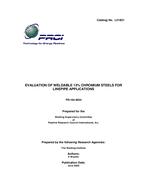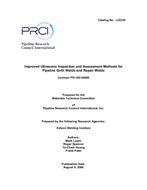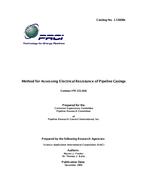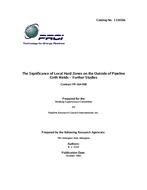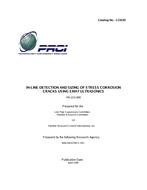Provide PDF Format
PRCI PR-164-9634
- Evaluation of Weldable 13% Chromium Steels for Linepipe Applications
- Report / Survey by Pipeline Research Council International, 06/01/2000
- Publisher: PRCI
$298.00$595.00
L51821e
The Welding Institute
Need: Steels with approximately 13%Cr have excellent resistance to acid solutions, such as are encountered in oil and gas production. Consequently, they are extensively used as downhole tubulars. However, traditional grades typically have carbon levels of 0.1% or more and invariably require pre-heat and postweld heat treatment when welding, to achieve sound joints without fabrication hydrogen cracks and with acceptable toughness. Hence, most use of 13%Cr steel for the oil and gas industry has involved mechanical coupling rather than welding, which has limited their application. In recent years, steel manufacturers have developed low carbon steels with approximately 13%Cr, which are being considered as "weldable" without need for pre-heat or postweld heat treatment (1-4). Such steels are candidate materials for linepipes where resistance to acid fluids containing CO2 is of primary importance. Steels with 13%Cr represent a significantly lower cost alternative to 22%Cr duplex stainless steels when use of carbon steel and inhibitor is not viable. Recent information suggests the cost of weldable 13%Cr pipe procurement may be as little as half that of 22%Cr duplex pipe, depending on precise composition. However, the resistance of 13%Cr steels to chloride ions and H2S is substantially lower than that of the competing duplex stainless steels.
Benefit: The overall aim of the project was to demonstrate the ability to produce welds suitable for linepipe applications in nominally weldable 13%Cr stainless steels covering the range of grades being marketed as low cost alternatives to 22%Cr duplex stainless steel. This included the following: (i) Development of welding guidelines giving sound joints in weldable 13%Cr steels, with minimum preheat requirement. (ii) Quantification of the mechanical, corrosion and environmental cracking properties of weldments in weldable 13%Cr steels. (iii) Quantification of the effect of brief PWHT cycles on weldment properties in weldable 13%Cr steels.
Result: Two seamless pipe samples, representing high and low alloy variants of weldable 13%Cr steel, were welded to give four different weldment types. The welding procedures were chosen to be reasonably representative of field welding procedures that might be selected for linepipes. Metallographic examination of the welds was performed, together with measurement ofx hardness, impact and tensile properties. Brief postweld heat treatment was studied as a means of reducing HAZ and fusion boundary hardness. Sulphide stress cracking and stress corrosion cracking tests were performed on cross-weld four point bend specimens exposed to mildly sour environments at room temperature and sweet environments at 120°C (248°F).
The Welding Institute
Need: Steels with approximately 13%Cr have excellent resistance to acid solutions, such as are encountered in oil and gas production. Consequently, they are extensively used as downhole tubulars. However, traditional grades typically have carbon levels of 0.1% or more and invariably require pre-heat and postweld heat treatment when welding, to achieve sound joints without fabrication hydrogen cracks and with acceptable toughness. Hence, most use of 13%Cr steel for the oil and gas industry has involved mechanical coupling rather than welding, which has limited their application. In recent years, steel manufacturers have developed low carbon steels with approximately 13%Cr, which are being considered as "weldable" without need for pre-heat or postweld heat treatment (1-4). Such steels are candidate materials for linepipes where resistance to acid fluids containing CO2 is of primary importance. Steels with 13%Cr represent a significantly lower cost alternative to 22%Cr duplex stainless steels when use of carbon steel and inhibitor is not viable. Recent information suggests the cost of weldable 13%Cr pipe procurement may be as little as half that of 22%Cr duplex pipe, depending on precise composition. However, the resistance of 13%Cr steels to chloride ions and H2S is substantially lower than that of the competing duplex stainless steels.
Benefit: The overall aim of the project was to demonstrate the ability to produce welds suitable for linepipe applications in nominally weldable 13%Cr stainless steels covering the range of grades being marketed as low cost alternatives to 22%Cr duplex stainless steel. This included the following: (i) Development of welding guidelines giving sound joints in weldable 13%Cr steels, with minimum preheat requirement. (ii) Quantification of the mechanical, corrosion and environmental cracking properties of weldments in weldable 13%Cr steels. (iii) Quantification of the effect of brief PWHT cycles on weldment properties in weldable 13%Cr steels.
Result: Two seamless pipe samples, representing high and low alloy variants of weldable 13%Cr steel, were welded to give four different weldment types. The welding procedures were chosen to be reasonably representative of field welding procedures that might be selected for linepipes. Metallographic examination of the welds was performed, together with measurement ofx hardness, impact and tensile properties. Brief postweld heat treatment was studied as a means of reducing HAZ and fusion boundary hardness. Sulphide stress cracking and stress corrosion cracking tests were performed on cross-weld four point bend specimens exposed to mildly sour environments at room temperature and sweet environments at 120°C (248°F).
Related Products
PRCI PR-185-04500
Ultrsonic Inspection of Hot Tap Branch Connections and Weld Sleeve-Fillet Weld using Phased Arrays..
$98.00 $195.00
PRCI PR-164-008
The Significance of Local Hard Zones on the Outside of Pipeline Girth Welds - Further Studies..
$98.00 $195.00
PRCI PR-155-909
In-Line Detection and Sizing of Stress Corrosion Cracks Using EMAT Ultrasonics..
$125.00 $249.00

